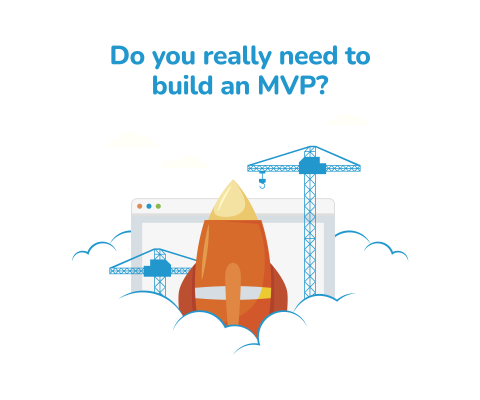December 4th, 2025, posted in for_founders
by Adelina
Do all software development projects require fully-packed teams, with managers, designers, testers and devs, or can you make do with just a few developers?
Every software project is unique. As much as we gotta follow industry standards, you can customize the way you build your software based on your needs, goals, budget and available resources (team and money).
Here are the two main ways you might go about building a piece of software:
- Hiring a software development outsourcing team. Hiring a team to build software for you leaves a lot of planning in their hands. Depending on what you’re building, they might assign multiple different roles to your project, or just a few developers.
- Doing it yourself. You can choose to build software in-house, and unless you don’t have developers in your team, you only need to hire a few devs - your managers should handle tasks, timelines and progress. You might need UI/UX designers and testers if it’s a big, custom project.
So in this article, we’re going to explain what goes into building a software project so you can determine what kind of roles you’ll need for your own.
What kind of roles do you need in a software team?
Let’s start with the basics. Most of us follow pretty standard procedures when building software - we assign a manager to handle organizing tasks, we do product discovery (mapping out user flows and app requirements), UI/UX design, we start coding the app, and we test and iterate until it’s done and ready to be released.
Right off the bat, you can detect a series of roles that are involved in such a process. So here’s a detailed explanation of what each of them does.
Project manager
With both small scale and larger scale projects, you’re always going to need a project manager. This team member holds all the information and is the gateway between the designers and developers and the project stakeholders.
In software development, project managers keep track of all tasks that need to be completed, they organize meetings with the product owners, they handle all communication with them, they hold status meetings with the designers and developers to keep track of progress, and overall they make sure everyone is doing what they’re supposed to, following the timeline set by the stakeholders.
How can a project manager help a product owner? Project managers will keep them up to date with everything happening in the project: the tasks that have been completed, tasks that are currently in progress, and those coming up next. They can also bring any questions the developers have to the product owners and organize meetings to discuss or brainstorm with them.
In other words, project managers bridge the gap between the technical part of the team and the project stakeholders. You can’t really rely on the designers and developers only, as they have plenty on their plate already. Asking them to do project management tasks can lengthen their work or delay the completion of their current tasks. Not to mention they might not be good at it, since it’s not their job.
UI/UX Designer
When starting a new project from scratch, with just a list of features and maybe a visual branding guide, it’s important to hire a UI/UX designer, or even 2 if it’s a larger-scale project. Their work will come first, before any development is done, as they will map out the entire look and feel of your app.
This will allow you to see exactly what the app will look like and how it’ll work, especially if the designers add prototyping to their screens. This way, you can see what you don’t like, what’s missing, what you can do without, and quickly reiterate with the designers.
Most importantly, UI/UX designers will know what works best in terms of looks & usability. Some developers might be good at design, but not on the same level as an actual designer. And UI/UX designers will also be good at mapping out user flows, user research, and overall coming up with the best user experience for your users.
What does that mean, long term? It means that your app will better serve its intended users, which means having happy customers, which means better conversion rates for app stakeholders. In other words, it’s a good return of investment.
Now, if you’re in a situation where you’ve worked with a designer already, finished the entire app design, and you want to move it into development, this can go in either of two ways:
- You decide not to hire a designer. You’ll have to stick to what’s in the design and build those features only, as there isn’t someone who could update the design.
- You’ll hire a designer in case you decide you want to add new things, change certain features or remove something that affects the look of specific pages.
So how do you decide if you need a UI/UX designer in your team or not? Well, if you don’t have an app design, you’ll need one. Chances are, even if you have a design already, you’ll still need one. Maybe not now, but later when feedback starts to come in, you might want to change things.
Tech Lead
We always have a tech lead in our dev teams. A tech lead is a senior developer, usually fullstack, who oversees the coding process and ensures that the devs don’t make major mistakes. They’re like a big brother, except they truly want what’s best for everyone.
Tech leads are particularly useful to have in large teams with junior or mid-level developers. They can help manage the technical aspect of things, while project managers only handle administrative things such as keeping track of tasks - but not specifically how the tasks are getting done.
They can help teach developers and lead them towards the right direction in the coding process. This is useful long term for the junior developers, and it also ensures that tasks are getting done well in software projects.
Now, you might ask, do I need a tech lead if I’ve hired 2 or more senior developers? Not really. You could designate the most senior of the ones you hired as the lead - they’d still code just as much as everyone else, but they would also oversee everyone’s work to make sure it’s going smoothly. But if your team has, let’s say, 7 years of experience each, you don’t really need someone else to lead them.
So when deciding if you need this role in your team or not, it’s best to look at the developers you’ve picked out already, look at your budget, the length and complexity of your project, or maybe even talk to the developers you’ve chosen already and ask if a tech lead would be helpful for them.
Backend & Frontend Developers (or Fullstack)
Backend developers handle the nitty gritty aspect of an app - the architecture, the database, and the way those blend in with the frontend (which is what users see). They hold a key role in building a software product and you can’t really skip out on hiring one.
Backend developers focus on the behind the scenes of what you usually see in an app, so hiring someone to do frontend but not also someone to do backend is like getting a house with no foundation.
Frontend developers, on the other hand, will bring to life what you see in your app designs. They focus on what meets the eye - the layout, colors, typography, any hover effects and animations, and so on. They build on the foundation made by the backend developers and use what comes out of that to create fully breathing apps.
Do you really need both of these? If you don’t want to hire 2 people (or can’t), you can look for a fullstack developer instead. A fullstack developer does both backend and frontend, so it’s the best of both worlds. Do expect this approach to take quite a while, as you’re putting a lot of work into the hands of one person. This can be ideal if you can’t find 2 separate people to do frontend and backend for your app - but having just one developer can be challenging.
If you’re building a small project, or adding new features to an already-existing project, one fullstack developer might be enough. But larger scale projects, that can take up to several months to build, might require 2 or more developers.
Quality Assurance or Testers
One inevitable part of building software is having bugs. It’s a given when writing code - you can write the best code in the world and little issues can still slip away. Even more so when building on top of an existing project, especially with new people who didn’t work on the original code. In other words, there’s a bigger risk if you’re hiring people to build on top of your existing code.
In software development, testing is usually handled by the quality assurance team. This team is composed of engineers and/or manual testers who will use the app to test its main functionality, but they’ll also use it in less conventional ways to try to break it.
By finding ways the app can be broken, especially trivial ways that regular users can, you’re also finding ways to fix it. You're not breaking the app to leave it so - you’re finding vulnerabilities to fix, just so actual customers won’t face those problems once you go live.
Can’t testing be handled by the developers? To a certain extent, they can. Developers often implement automatic tests into their code, which can help avoid major bugs. But automated testing can’t cover the human part of things - people tend to click on the wrong thing by accident, they forget things, or they don’t pay attention to key information.
So in most projects, especially larger scale ones, it’s crucial to have a quality assurance team that can check the software for bugs.
When would you need a complex, cross-functional team?
Whether or not you need a full, complex team of people largely depends on the type of software you’re building, its size and complexity. The more complex, the more people you’ll need.
Here are a few variables to consider when deciding if you need a full software outsourcing team:
- Have you clearly mapped out what you’re trying to build? The clearer you are about your project requirements, the easier it will be to estimate what you need to get it done. This way, when you talk to a developer about your requirements, they’ll know if they can pull it off or if you need a whole entire team of people.
- Do you have a design, or do you even need one? If you already have a design, or you’re using a theme or template, you don’t need to hire a UI/UX designer. Keep in mind, if you decide to change UI elements, not all software developers are good at making it look pretty.
- What’s your budget? It goes without saying that it’s cheaper to hire one or two developers instead of an entire team spanning different roles. If you’re on a lower budget, you might have to handle project management and testing in-house, and use templates instead of custom designs.
- Is your software project complex and could span over several months or even years? A complex project requires a complex team. It’s not easy to build software, let alone a complex app. It’s best to hire a cross-functional team the more complex your project is.
- Are you building an entire app from scratch or just adding things to an existing app? If you’re just adding new features, you might be able to get away with just hiring a designer and a developer. But an entire app might need a full, dedicated team.
In other words, there are a lot of variables that influence whether or not you’d need a full team or just a few developers.
In what kind of situations can you make do with just a few developers?
- When you’ve got a design already and it’s fully approved and/or finished
- When your own team can handle project management & testing
- When your budget can’t handle a long term project or a team made out of 5-6 people
- When you’re in a hurry to release updates or bug fixes
- When you just want to update & refine your software from time to time
- When you don’t need to rethink user flows or do user research, you know exactly what you want & need for your software.
One other method you can adopt is hiring a UI/UX designer and one or two developers. This way, the designer can better prep your new features in terms of visuals and user flows, and the developers will code them faster and more accurately. If you’re just adding small updates or reiterating parts of your app, this is a good approach when you’re on a smaller budget.
All in all, whether you hire a full software development team or just a few developers really depends on the kind of project you’re working on, your budget, existing team, timeline, and really just what you personally prefer. The bigger the project, the more people you might need.
We, also, offer either a full software team, or one-two developers for your software projects. You can always enquire about our dev’s resumes, or you can message us and we can chat about what best fits your software project.

















